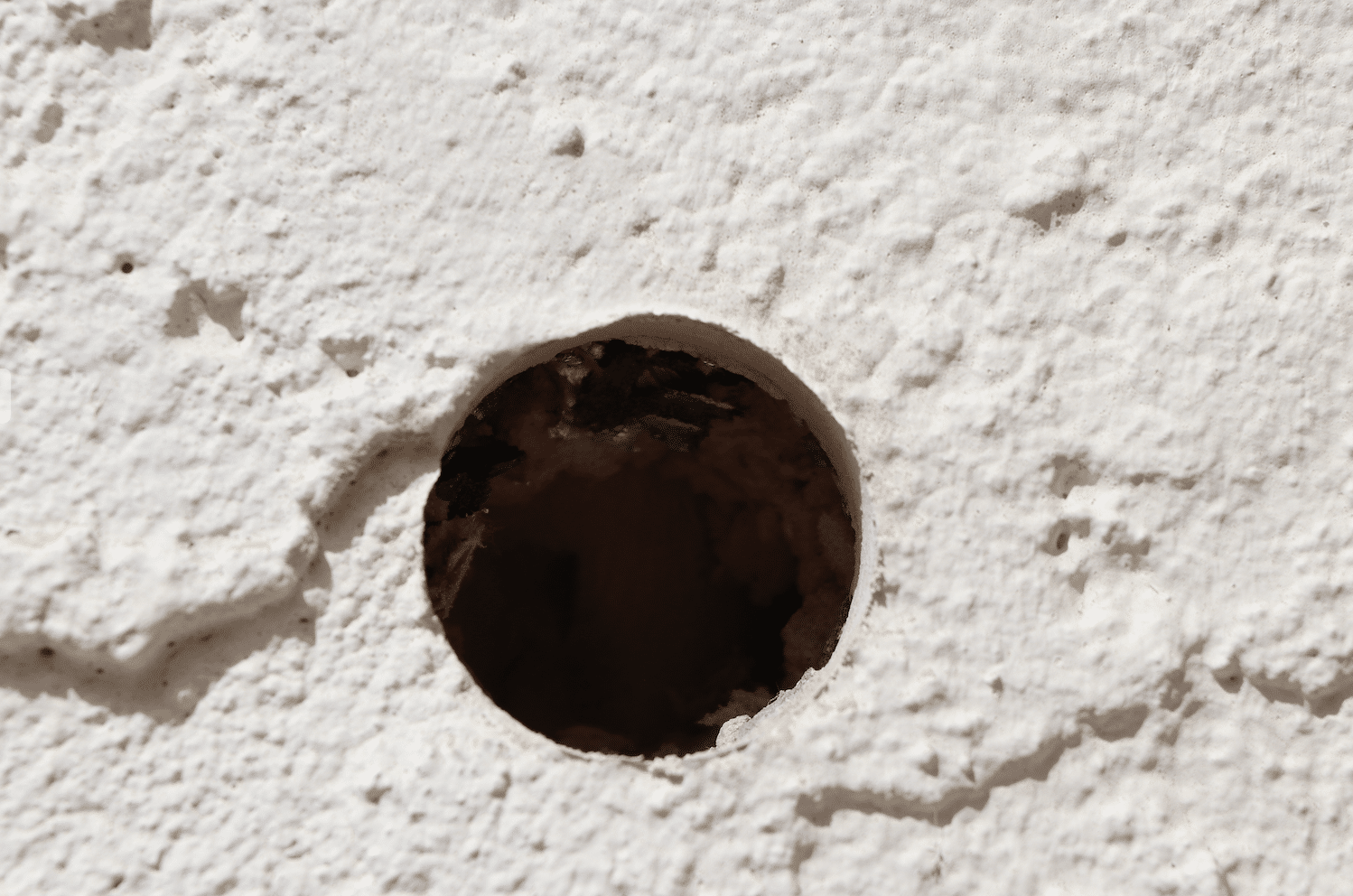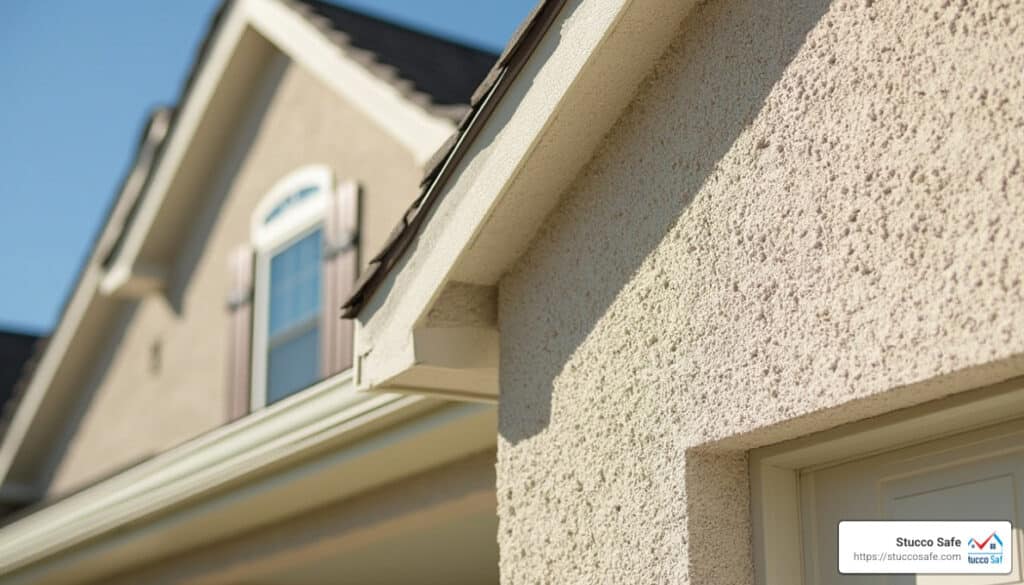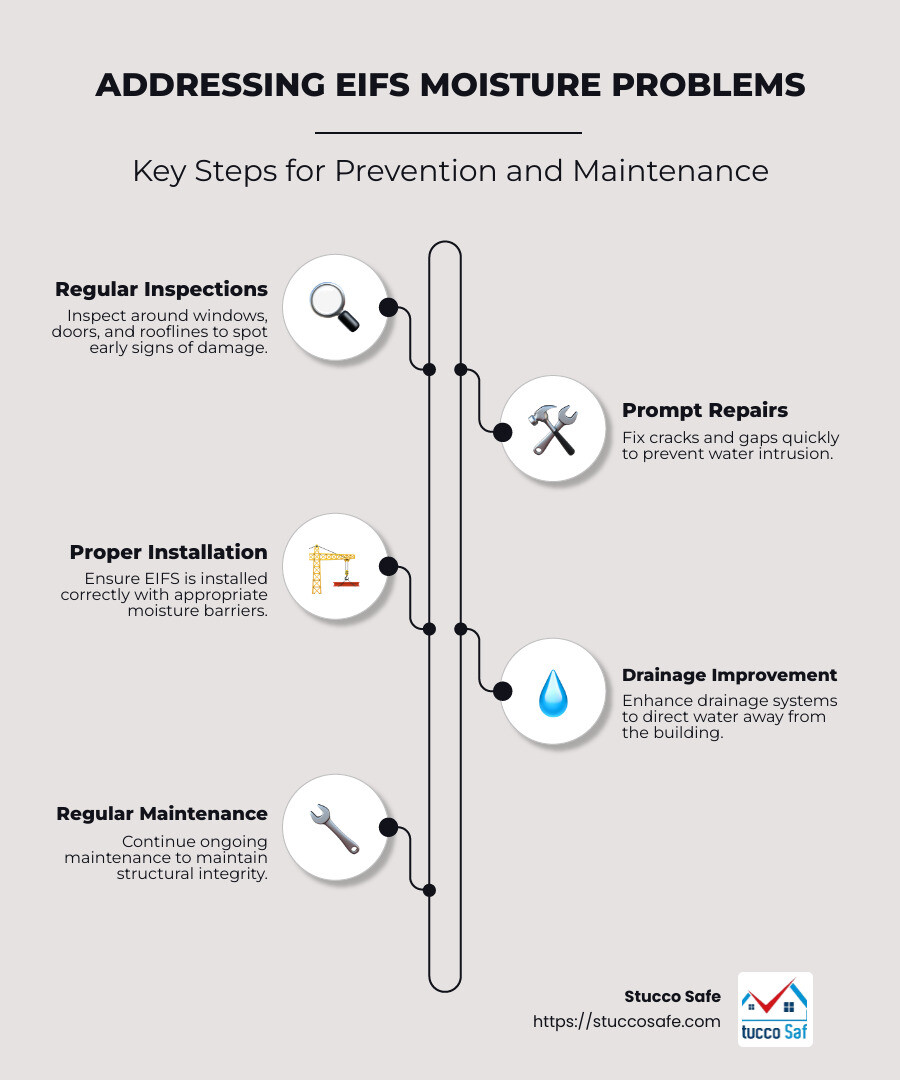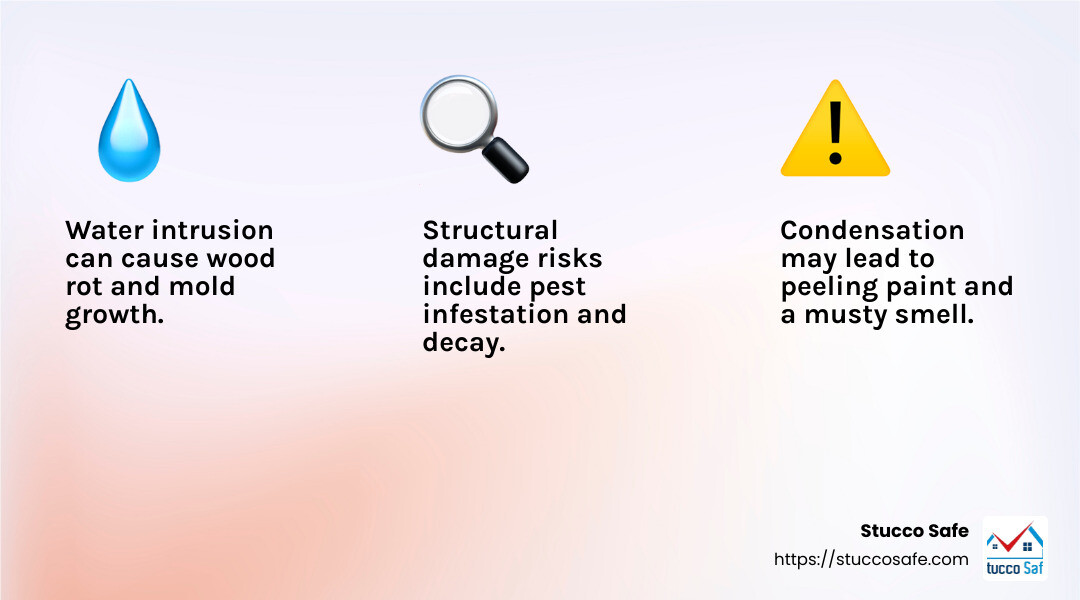EIFS moisture problems are becoming a common concern for homeowners in Southeastern Pennsylvania and beyond. These issues often stem from improper installation or inadequate moisture barriers, leading to serious consequences like mold growth or structural damage.
Here’s what you need to know about EIFS moisture problems:
- Water intrusion can cause hidden damage to both the exterior and interior of your home.
- Regular inspections, especially around windows, doors, and rooflines, are vital.
- Prompt repairs to any cracks or gaps can save you money in the long run.
Exterior Insulation and Finish Systems (EIFS), sometimes known by the name “Drivit,” provide energy efficiency and aesthetic appeal. However, without proper maintenance and inspection, they might trap moisture, causing damage that is often invisible until it’s too late. This makes a thorough inspection crucial for maintaining your home’s structural integrity.
My name is Gabe Kesslick, and I’ve been dealing with EIFS moisture problems since starting Stucco Safe in 2015. My expertise lies in tackling EIFS-related issues through detailed inspections and preventative maintenance strategies. In my experience, addressing moisture problems early saves homeowners from costly repairs later on.
To continue exploring this topic, let’s dig into understanding EIFS complexities and its common vulnerabilities.
Understanding EIFS and Its Vulnerabilities
Exterior Insulation and Finish Systems (EIFS), often called synthetic stucco, are popular for their energy efficiency and sleek appearance. EIFS is a type of exterior cladding material that plays a crucial role in building performance and maintenance. But, like all systems, EIFS has its vulnerabilities.
Synthetic Stucco
Synthetic stucco is not the same as traditional stucco. Traditional stucco is made from Portland cement, sand, and lime, applied wet over surfaces like brick or wood. Synthetic stucco, on the other hand, involves multiple layers including an insulation board, a water-resistant base coat, fiberglass mesh, and EIFS material as part of the finish system. This composition offers better energy efficiency and weather resistance.
However, synthetic stucco can lead to EIFS moisture problems if not properly installed or maintained. It’s crucial to understand how these systems work to prevent issues.
Barrier vs. Drainage Systems
EIFS comes in two main types: barrier and drainage systems.
- Barrier EIFS: This system relies on a perfect seal to keep water out. Any break in this seal can lead to moisture problems. Because it doesn’t allow water to escape, trapped moisture can lead to wood rot and mold growth. Additionally, exterior gypsum sheathing used in barrier EIFS installations is particularly vulnerable to water intrusion if not properly maintained, which can cause moisture-related damage and structural deterioration.
- Drainage EIFS: This system includes a drainage plane, allowing water to escape. It is generally more effective in preventing moisture problems, as it provides a path for water to exit the building envelope.
Choosing the right system and ensuring proper installation are key to avoiding EIFS moisture problems.
Installation Challenges
A challenge with EIFS is installation. Even minor errors can lead to significant issues. Common installation mistakes include:
- Improper sealing: Failing to seal joints around windows, doors, and other openings can allow water to enter.
- Inadequate flashing: Missing or poorly installed flashing around rooflines and other intersections can lead to water intrusion.
- Lack of drainage: Without proper drainage, water can become trapped, leading to moisture buildup.

A perfect installation is rare, and even small mistakes can have big consequences. Regular inspections and maintenance are essential to catch and address these issues early.
In the next section, we’ll explore the common moisture problems faced by EIFS and how they can impact your home.
Common EIFS Moisture Intrusion Problems
EIFS systems are great for energy efficiency and a sleek look, but they do have their own set of challenges. Let’s explore the most common EIFS moisture problems and how they can affect your home.
Moisture penetration can lead to issues like soft spots, discoloration, and mold growth, which may result in significant repairs and insurance complications, especially in regions with high humidity.
Water Intrusion
Water intrusion is a major issue for EIFS systems. It usually happens due to improper installation or maintenance. Common culprits include:
- Failed Sealants: Over time, caulk can dry out or crack, letting water seep in.
- Improper Flashing: If roof flashing isn’t installed correctly, water can pool and find its way behind the EIFS.
- Cracks: Even tiny cracks in the EIFS surface can let water in.
When water gets behind the EIFS, it can lead to serious issues like wood rot and mold growth. It’s important to address these entry points quickly to prevent damage.
Condensation
Condensation is a sneakier problem. It happens when temperature differences between the inside and outside of your home cause moisture to build up. Signs of condensation include:
- Peeling Paint: This can indicate trapped moisture.
- Musty Smell: A telltale sign of moisture in wall cavities.
The use of interior vapor barriers can lead to inadequate drying and increase the risk of moisture damage in hot-humid climates, as these barriers may trap moisture and cause deterioration of building materials.
While not as obvious as water intrusion, condensation can still cause extensive damage over time. Regular checks and maintaining a balance in indoor humidity can help.
Structural Damage
When moisture problems persist, they can lead to significant structural damage. Here’s how:
- Wood Rot: Continuous moisture exposure can cause wood framing to decay.
- Mold Growth: Mold thrives in damp conditions and can spread quickly.
- Pest Infestation: Carpenter ants and termites find damp EIFS environments inviting.
These issues don’t just affect the aesthetics of your home; they can compromise its structural integrity. Regular inspections and prompt repairs are key to preventing these problems.
Identifying these moisture issues early can save you from costly repairs. In the next section, we’ll discuss how to spot these problems before they escalate.
Factors that Contribute to Moisture Intrusion
Moisture intrusion is a common issue in Exterior Insulation and Finish Systems (EIFS), and understanding the contributing factors is crucial for prevention and maintenance. Here are some key factors that can lead to moisture problems:
Identifying EIFS Moisture Issues
Spotting EIFS moisture problems early is crucial to avoid costly repairs and maintain your home’s structural integrity. Here’s how you can identify these issues before they escalate.
Visual Inspection
Start with a simple visual inspection. Look for signs like:
- Cracks: Even small cracks in the EIFS surface can allow water to seep in. Pay special attention to areas around windows and doors.
- Discoloration: Stains or patches of different colors can signal moisture problems beneath the surface.
- Bulging or Swelling: Parts of the wall that appear uneven or swollen might indicate trapped moisture.
- Peeling Paint: This can be a sign of moisture buildup leading to paint detachment.
Regularly walking around your home and checking these signs can help catch problems early.
Moisture Probes
For a more in-depth inspection, using moisture probes is effective. These tools measure the moisture content within the EIFS system. Here’s how they work:
- Probe Different Areas: Focus on vulnerable spots like joints, roof intersections, and around penetrations (e.g., pipes, light fixtures).
- Monitor Readings: High moisture readings can indicate water trapped behind the EIFS, which might not be visible externally.
Moisture probes provide a deeper understanding of what’s happening beneath the surface, allowing for targeted interventions.
Signs of Damage
Beyond visual cues, other signs can indicate moisture issues:
- Musty Odors: A persistent earthy smell can suggest hidden moisture or mold.
- Soft Spots: Areas that feel spongy when pressed might have underlying water damage.
- Rusting Metal Components: Visible rust on metal fasteners and lath can point to moisture infiltration.
These signs often indicate that moisture has been present for some time, and immediate action is needed.
Identifying these issues early can prevent minor problems from becoming major headaches. In the following section, we’ll explore solutions to tackle and prevent EIFS moisture problems effectively.
Solutions for EIFS Moisture Problems
Tackling EIFS moisture problems requires a proactive approach. Let’s explore some key solutions that can help protect your home from moisture damage.
Proper Installation
The foundation of a moisture-resistant EIFS system lies in its installation. A well-installed system can prevent many moisture issues from arising.
- Follow Manufacturer Guidelines: Ensure the installation adheres strictly to manufacturer specifications and local building codes.
- Seal Openings Carefully: Pay close attention to sealing around windows, doors, and any penetrations to prevent water entry.
- Use Quality Materials: Invest in durable and water-resistant materials to improve the system’s longevity and performance.
Proper installation is your first line of defense against moisture-related problems.
Regular Maintenance
Once installed, regular maintenance is crucial to keep your EIFS system in good condition.
- Inspect Sealants and Flashings: Routinely check these components for wear and tear. Replace them promptly if they show signs of drying out or cracking.
- Address Cracks Immediately: Even minor cracks can be entry points for water. Repair them as soon as they appear.
- Maintain Height Above Ground: Ensure the EIFS system maintains the recommended height above ground level to avoid splash-back wetness.
Regular maintenance helps catch small issues before they escalate into larger, costlier problems.
Drainage Improvements
Enhancing drainage is an effective way to manage moisture and prevent it from being trapped within the EIFS system.
- Consider EIFS with Drainage: This improved system includes drainage channels that help evacuate any accumulated moisture.
- Install Weep Screed: Weep screeds at the base of walls allow water to escape, preventing buildup.
- Check Roof and Flashing: Ensure rooflines and flashing are correctly installed to divert water away from the EIFS.
Improving drainage systems is a proactive step to reduce the risk of moisture-related damage.
By focusing on these solutions, you can effectively manage EIFS moisture problems and safeguard your property’s structural integrity and aesthetic appeal.
In the next section, we’ll address some frequently asked questions about EIFS moisture issues to further guide you in maintaining a healthy and durable exterior.
Repairing Water-Damaged EIFS
Repairing water-damaged EIFS requires a thorough assessment and a systematic approach to ensure the integrity of the system is restored. Here are the steps to follow:
When to Remove EIFS Due to Moisture Damage
In some cases, the extent of moisture damage may necessitate the removal of the EIFS system. Here are scenarios where removal might be the best course of action:
Frequently Asked Questions about EIFS Moisture Problems
What are the main moisture issues with EIFS?
EIFS moisture problems often stem from two main culprits: water intrusion and condensation. When water seeps through gaps or cracks, it can lead to wood rot and mold growth, which are serious concerns for any homeowner.
- Water Intrusion: This occurs when water penetrates through the EIFS barrier due to failed sealants or improper installation. Over time, this can cause significant damage to the underlying structure.
- Wood Rot: Once moisture infiltrates, it can lead to the decay of wood framing, compromising the structural integrity of your home.
- Mold Growth: Excessive moisture creates an ideal environment for mold, which can pose health risks and further damage building materials.
How can EIFS moisture problems be prevented?
Preventing moisture issues with EIFS involves a combination of proper installation, regular inspections, and effective drainage systems.
- Proper Sealing: Ensure all openings, such as windows and doors, are thoroughly sealed to prevent water entry. High-quality sealants like Sikaflex™ are recommended for their durability.
- Drainage Systems: Opt for EIFS with drainage capabilities to allow any trapped moisture to escape, reducing the risk of damage.
- Regular Inspections: Conduct routine checks to identify and address potential issues early. Inspections can range in cost from $495 to $1595, depending on the size of the home.
What are the signs of EIFS moisture problems?
Spotting the early signs of moisture issues can save you from costly repairs down the line. Keep an eye out for:
- Cracks and Bulging: These are often the first visible signs of water intrusion. Even small cracks can lead to significant problems if left unattended.
- Discoloration: Changes in the color of the EIFS finish can indicate moisture buildup beneath the surface.
- Musty Odors: A persistent musty smell indoors can suggest mold growth, even if it’s not immediately visible.
Regular attention to these signs will help maintain the health and appearance of your EIFS system. In the next section, we’ll explore how Stucco Safe offers professional inspection services to ensure your home remains protected against moisture-related challenges.
Conclusion
EIFS moisture problems can be daunting, but with the right approach, they are manageable. That’s where Stucco Safe comes in. We specialize in professional inspection services that focus on identifying and solving these issues before they become major headaches.
Our team uses forensic testing methods, which means we don’t just look at the surface. We dig deeper to find hidden problems that might not be visible to the naked eye. This thorough approach ensures that we catch issues early, saving you time and money in the long run.
Whether you’re dealing with water intrusion, wood rot, or mold growth, our certified inspectors are here to help. We serve a wide area, including Southeastern Pennsylvania, New Jersey, and Delaware, providing expert services custom to your needs.
By choosing Stucco Safe, you gain peace of mind knowing your property is in good hands. Regular inspections and maintenance are key to keeping your EIFS system in top shape.
If you’re in Pennsylvania, Delaware, New Jersey or New York and need an EIFS inspection, contact us today to schedule a professional inspection. Let’s work together to protect your investment and ensure your home stays safe and sound.



